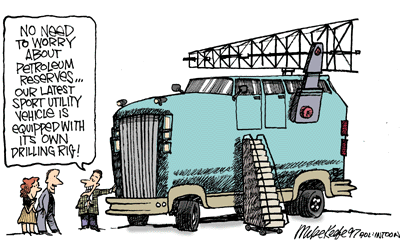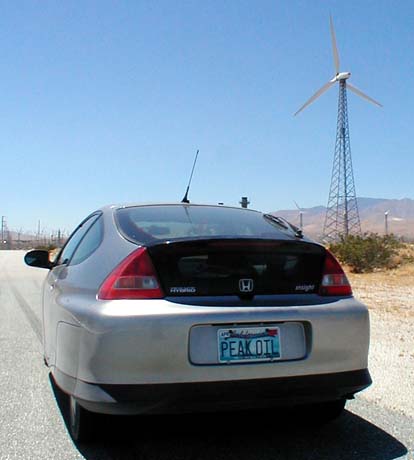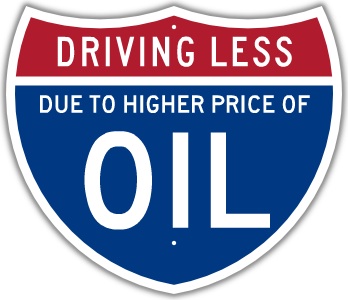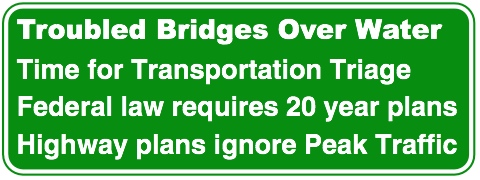Transportation Plans Assume Endless Cheap Oil
Federal law requires that federal aid highways must be designed for traffic two decades in the future, not merely to address current traffic congestion. A more important question is what type of an economy we will have two decades in the future, after the cheap abundant oil is replaced by expensive, scarce oil.
 While it is impossible to project what oil will cost when global extraction
is roughly half of current levels (as the US Department of Energy has projected may be the
case in 2030), it seems obvious that oil will cost significantly more, if it
is not rationed. Whatever the price increase, it will force significant changes
in travel patterns that must be factored into transportation and land use planning.
While it is impossible to project what oil will cost when global extraction
is roughly half of current levels (as the US Department of Energy has projected may be the
case in 2030), it seems obvious that oil will cost significantly more, if it
is not rationed. Whatever the price increase, it will force significant changes
in travel patterns that must be factored into transportation and land use planning.
These projections completely ignore any natural limitations to sprawl development such as finite petroleum supplies, water issues, or other limits to growth. If highway planning had to include the reality of the peak of petroleum production, massive road expansion would seem even sillier. The best projections suggest that in the 2030s most of the world's oil extraction outside the Middle East will have been exhausted, and therefore the Saudi, Iraqi, Iranian, etc. oil fields will be of even more importance to the global economy. However, by then, even those fields will be in obvious decline. Will we use the remaining oil to relocalize production and build lots of renewable energy equipment (solar panels, wind mills, etc) or will this oil be used in a futile world war to control the oil fields (which will result in nothing left over after the oil wars to power our societies)?
As the world passes the peak of global petroleum production, gasoline prices are likely to increase to the point that traffic demands on roads will be reduced. While it is impossible to accurately predict the price of fossil fuels in the design year of 2030, it will be surprising if gasoline is not rationed on the downslope of the Peak Oil curve (either directly by ration cards or indirectly by pricing it out of reach of many who currently consume it). While so-called alternative fuels exist and there are vehicle designs much more efficient that current models, they are only going to be able to mitigate the energy downslope. Carpooling is going to be more important than hybrids.
 The 1991 ISTEA law requires all highway plans in a metropolitan area to fit into a regional long range transportation budget to avoid a form of fiscal segmentation. If a metro area wants lots of new roads, they have to show how the projects could be paid for (federal and local funds) over a 20 year period. Approving a project that lacks funding is therefore a form of segmentation. The funds need not be available when construction begins, but the entire project has to fit within a constrained transportation budget - a process similar to buying a home with a mortgage (a home buyer has to show their potential ability to raise all of the funds over the span of the loan).
The 1991 ISTEA law requires all highway plans in a metropolitan area to fit into a regional long range transportation budget to avoid a form of fiscal segmentation. If a metro area wants lots of new roads, they have to show how the projects could be paid for (federal and local funds) over a 20 year period. Approving a project that lacks funding is therefore a form of segmentation. The funds need not be available when construction begins, but the entire project has to fit within a constrained transportation budget - a process similar to buying a home with a mortgage (a home buyer has to show their potential ability to raise all of the funds over the span of the loan).
While no one, not even Dick Cheney, knows precisely what will happen with Peak Oil, to ignore it completely and make more "growth" projections and traffic models that assume constant supplies and pricing of petroleum is delusional. When FHWA finally requires energy analyses in NEPA documentation, they could examine a range of scenarios: gasoline at $10 per gallon in 2030, gasoline at $100 per gallon in 2030, and gasoline not available to the public in 2030 (only to elites and the military)
The reality of Peak Oil and climate change means that the continent wide rush to build more bypasses, wider bridges, Outer Beltways and NAFTA Superhighways will not be needed. There are no road projects known to this writer anywhere in North America that have been scaled back or canceled because of Peak Oil and Peak Traffic.
Government planners pretend Peak Oil is irrelevant
"real fuel prices are assumed to increase from $1.50 [per gallon] in 2002 to $2.50 by 2025, while average vehicle fuel economy increases from 20 to 30 mpg."
- Lane Council of Governments, Eugene, Oregon, December 2004, Central Lane MPO 2004-2025 Regional Transportation Plan, Air Quality Conformity Determination, p. 23
[note: LCOG was only off by 19 1/2 years in their prediction for gasoline price increases]
The 2005 Final Environmental Impact Statement for the Inter County Connector highway (I-370 or Maryland Route 200) in Maryland, part of the long planned Outer Beltway around Washington, D.C., had this response to a comment that referenced Peak Oil as a reason not to build the road:
It is speculative to assume that increases in gasoline prices will "reduce congestion." Evidence indicates that very substantial price increases might be needed in order to substantially change transportation choices and decisions. Price increases could cause a variety of responses which might not affect highway usage; e.g. production and acquisition of more fuel-efficient vehicles. The travel forecasts were made assuming a cost per mile for operating an automobile. Historically as the price of gasoline has increased the miles traveled per gallon of gas have also increased. In fact, gas costs less per mile traveled today than it did prior to the first oil embargo in 1974. Petroleum scarcity as a result of consumption in China is speculative.
Final Environmental Impact Statement, Inter County Connector
This EIS was correct to state that planning for rising gas prices is speculative, but planning as if prices will remain constant for the next two decades is even more speculative.
It is not "speculation" to predict that higher gas prices will prevent traffic increases.
Traffic levels peaked in Maryland in 2007. The ICC opened in 2011. Traffic levels on the toll road have been significantly less than projected, which has depressed toll revenues.
2008 Columbia River Crossing Draft Environmental Impact Statement
Interstate 5 Columbia River Crossing
Energy Technical Report
Affected Environment
4-2 May 2008Historically, world oil prices have varied considerably and are expected to continue to exhibit high fluctuations as a result of political instability, access restrictions, and a reassessment of OPEC producers' ability to influence prices during periods of volatility. As a result, the 2030 national supply of petroleum could vary substantially depending on world oil prices. Due to global political and economic uncertainties, the USDOE Annual Energy Outlook world oil prices in 2030 were forecasted for three scenarios: "High Price," "Reference Price," and "Low Price" with the cost of oil at 100, 59, and 36 dollars per barrel, respectively (in 2005 dollars). In November 2006 the price of crude oil was about 60 dollars per barrel. One year later it had risen to between 90 and 100 dollars per barrel (2007 dollars). Depending on the world oil prices, the 2030 projections for petroleum imports ranged from 13.4 million barrels per day for the High Price scenario, 17.7 million barrels per day for the Reference Price, and 20.8 million barrels per day for the Low Price scenario.
The 100 dollar a barrel price was reached four months before the publication of the DEIS, not in the year 2030. Therefore, the traffic analysis for the CRC needs to be redone to factor in geological and financial reality - the end of cheap oil is here (regardless of the precise timing of Peak Oil).
The CRC Draft EIS is probably the first to acknowledge the reality of Peak Oil, but unfortunately, the writers of this section failed to describe it accurately. The DEIS suggests that there is a maximum scenario for the year 2030 of $100 a barrel for oil, yet this figure was reached on the first trading day of 2008, four months before the publication of the DEIS. It is astounding that there is no mention in the DEIS of the substantial rise in oil prices during preparation of this report.
One bright spot in the DEIS is the mention of the Department of Energy’s Hirsch Report (2005), although the DEIS failed to mention the conclusions of this analysis. The Hirsch Report stated that we would need twenty years to mitigate the impact of Peak Oil, even if we were using toxic technologies such as coal-to-liquids and tar sands. While the Hirsch Report did not specify an opinion on when the Peak would be, oil production worldwide has been essentially flat since 2005 as new oil fields have had a difficult time making up for declining oil fields in the North Sea, Alaska, the Persian Gulf and other areas.
"fossil fuels are not in short supply at this time, and the use of these resources would not have an adverse effect on their continued availability."
-- Newberg Dundee Bypass, Oregon, Draft Environmental Impact Statement, (2008), p. 4-3
EN: Energy
One commenter provided comments regarding peak oil, climate change, and the relationship between the cost of fuel and the demand for driving. The FHWA has been actively engaged in preparing for transportation changes that may result from larger-scale issues such as peak oil, climate change, and other externally caused actions. Although formal policies are still emerging for many of these issues, planning for such changes is occurring. This planning takes many forms including alternative fuels, new modes of travel (mass transit, bicycle/pedestrian), sustainable design, and other measures. Many new infrastructure projects are allowing for increased use of transit (buses, light rail, trains) and bicycle/pedestrian travel to reduce oil and gas consumption while maintaining the public's mobility. Peak oil is not identified as an issue in which analysis can provide meaningful information to the public or decision makers regarding which alternative to select for the Sunrise Project. Government agencies are considering future conditions in planning for public infrastructure projects. It is also important to note that, while fuel types and supplies may change, transportation agencies are still planning to provide needed infrastructure and improvements to ensure continued movement of goods and people in the future. The Sunrise Project contributes to these efforts.-- Sunrise Project, I-205 to Rock Creek Junction, Final Environmental Impact Statement, December 2010, Chapter 5 - Comments and Responses, pp. 350-351
Peak Oil Plateau: Growth is Over
Peak Oil does not mean that civilization is about to run out of oil. Instead, we are near (or at) the point where continued growth of petroleum combustion no longer can be maintained, which will have profound consequences for the global economy that is dependent on exponential growth of nearly everything (especially of money supplies). Energy creates the economy, a physical limitation rarely acknowledged by economists. Peak Oil is also the point where the maximum amount of economic "growth" is reached -- and ideally a turning point where we can decide to use the remaining half of the oil as a bridge toward a more sustainable way of living. It would require enormous energy, money and people power to reorient away from NAFTA Superhighways toward investing in bullet trains, away from dirty fossil fuel technologies toward efficiency and renewable energy systems, away from resource wars and toward global cooperative efforts to reduce our collective impact on the planetary biosphere.
Alternative fuels and plug-in hybrids won't reverse Peak Traffic
 Renewable energy systems are largely focused on generating electricity. Transportation systems are almost entirely based on burning liquid fuels, which are not generated by solar PV power or wind turbines.
Renewable energy systems are largely focused on generating electricity. Transportation systems are almost entirely based on burning liquid fuels, which are not generated by solar PV power or wind turbines.
A bigger problem is that in the coming decades natural gas suppliesin the US are likely to have dropped so low that they will no longer be able to be used to generate electricity -- the remaining gas will be needed to heat buildings, especially in the colder climates where the gas is extracted from. Whatever renewable energy systems are installed between now and then will need to replace the substantial inputs that natural gas has for the electric power grid at the same time that there is less available energy to manufacture solar panels and wind turbines.
All of the major car companies have developed much more efficient vehicles (Greenpeace, "The Environmental Impact of the Car," 1992), with many models around 100 mpg. VW even has a small model that is highway rated that gets about 250 mpg -- the VW CEO drove it to their annual stockholder meeting a few years ago. While technological shifts may help mitigate the energy crisis after Peak Oil, it cannot eliminate the problem. There are no factories to make these vehicles. There are no capital investments to fund the conversion of existing factories to make hyper-efficient cars. The existing fleet of vehicles are not going to be instantly eliminated in favor of efficient cars, as the owners have invested heavily in their current models -- someone who bought a $50,000 SUV is not easily going to be able to absorb the loss by purchasing a new car that is more efficient. At best, the investment in more efficient vehicles may slow the decline of VMTs on the Peak Oil downslope -- but it cannot prevent that decline. There is also the problem of substantial use of oil and mineral ores to manufacture new cars, even efficient ones. Carpooling is a more promising short term mitigation than hoping for 100 mpg cars.
Electric cars, even if a hundred million were instantly produced and distributed (in factories that don't exist), could not substitute for food delivery trucks, tractors, freight trains, most Amtrak trains, container ships that bring us cheap crap from Chinese slave labor factories, passenger planes, cargo planes, war planes, petrochemicals for non-transport purposes, fossil fuels used to heat homes and run factories, depleting natural gas used to power part of the electric power grid, oil use at mines and many other uses that show we are not addicted to oil -- we are extremely dependent upon it and the "alternatives" are less concentrated and therefore unable to substitute completely.
www.registerguard.com/news/2005/12/14/ed.letters.1214.p1.php?section=opinion
Don't underestimate peak oil
The profile of the new Oregon Transportation Plan, "Road map: How to get there from here," (Register-Guard, Dec. 5) mentions the concept of "peak oil" as a transportation planning issue, but then downplays its significance, claiming that the peak of production might happen in the next two decades.
In April, Oregon Secretary of State Bill Bradbury told an audience in Eugene that we are at peak oil. Most petroleum geologists agree that the peak is either here or will be here soon, and that the megafields discovered more than four decades ago are showing signs of depletion. A good scientific introduction to these issues can be found on the Web site of the Association for the Study of Peak Oil, www.peakoil.net
Peak oil will require us to conserve energy and to live more locally. The promise of hydrogen-powered cars is a distraction from practical solutions to reduce consumption, since hydrogen is a means to store energy, not an energy source (you still need energy to make it). The Oregon Transportation Plan should recommend improved train service in the Willamette Valley and coordinate with economic planners to relocalize production of goods to reduce demand for delivery trucks.
At 7 p.m. on Jan. 10 [2006], the Eugene Permaculture Guild is sponsoring a lecture by Richard Heinberg at the Eugene Hilton. Heinberg is author of "The Party's Over" and "Powerdown: Options and Actions for a Post Carbon World," which describe how communities can cooperate to mitigate the impacts of energy decline.
MARK ROBINOWITZ
Eugene
www.kunstler.com/mags_diary16.html
James Howard Kunstler
February 6, 2006
By now, President Bush's wildly irresponsible remarks on energy in his state of the union speech may have already vanished down the memory hole, but the damage will linger on. "America is addicted to oil," Mr. Bush began, failing to mention that underlying this addiction was a living arrangement that required people to drive their cars incessantly. A clueless public will continue to believe that "the best way to break this addiction is through technology. . ." and that "we must also change how we power our automobiles."
Mr. Bush recommended ethanol. As one wag put it after the speech: "America's heroin is oil, and ethanol will be our methadone." The expectation will still be that everybody must drive incessantly.
It is hard to believe that Mr. Bush does not know the truth of the situation, or that some of the clever people around him who run his brain do not know it, namely that ethanol and all other bio-fuels are net energy losers, that they require more energy to grow and process them than they produce in the end, and that the energy "inputs" required to do this are none other than oil and natural gas, the same fuels we already run engines on.
The president also said that "breakthroughs on this and other new technologies will help us reach another great goal, to replace more than 75 percent of our oil imports from the Middle East by 2025."
In point of fact, our oil imports from anywhere on the planet will be reduced by more than 75 percent because by that time worldwide oil depletion will be advanced to its terminal stage, and nobody will have any oil left to export -- assuming that the industrial nations have not ravaged each other by then in a war to control the diminishing supply of oil.
The key to the stupidity evinced by Mr. Bush's speech is the assumption that we ought to keep living the way we do in America, that we can keep running the interstate highway system, WalMart, and Walt Disney World on some other basis besides fossil fuels. The public probably wishes that this were so, but it isn't a service to pander to their wishes instead of addressing the mandates of reality. And reality is telling us something very different. Reality is saying that the life of incessant motoring is a suicidal fiasco, and if we don't learn to inhabit the terrain of North America differently, a lot of us are going die, either in war, or by starvation when oil-and-gas-based farming craps out, or in civil violence proceeding from failed economic expectations.
I hate to keep harping on this, but Mr. Bush could have announced a major effort to restore the American railroad system. It would have been a major political coup. It would have a huge impact on our oil use. The public would benefit from it tremendously. And it would have put thousands of people to work on something really meaningful. Unlike trips to Mars and experiments in cold fusion, railroads are something we already know how to do, and the tracks are lying out there waiting to be fixed. But the reigning delusions of Hollywood and Las Vegas prevent us from thinking realistically about these things. We're only into wishing for grand slam home runs and five-hundred-million-dollar lottery jackpots. Anything less than that makes us feel like losers.
Meanwhile, the official Democratic Party response to Mr. Bush's fucking nonsense was the stupendous fatuousness of newly-elected Virginia Governor Tim Kaine's rebuttal, a saccharine gruel of platitudes and panderings ...
History will look back in wonder and nausea at the twitterings of these idiots as the world they pretended to run lurched into darkness.
| The National Environmental Policy Act (NEPA) requires a revision to the Environmental Impact Statement to address the new information about Peak Oil and climate change. |
40 CFR 1502.9: Draft, final and supplemental statements.
(c) Agencies:
(1) Shall prepare supplements to either draft or final environmental impact statements if:
(i) The agency makes substantial changes in the proposed action that are relevant to environmental concerns; or
(ii) There are significant new circumstances or information relevant to environmental concerns and bearing on the proposed action or its impacts.23 CFR § 771.130 Supplemental environmental impact statements.
(a) A draft EIS, final EIS, or supplemental EIS may be supplemented at any time. An EIS shall be supplemented whenever the Administration determines that:
(1) Changes to the proposed action would result in significant environmental impacts that were not evaluated in the EIS; or
(2) New information or circumstances relevant to environmental concerns and bearings on the proposed action or its impacts would result in significant environmental impacts not evaluated in the EIS.
The Peak of global petroleum extraction is a "new circumstance" that impacts the purpose and need for any federally funded transportation project.
"In conjunction with the Oregon Department of Energy, Metro will develop
a contingency plan for dealing with short term gasoline shortages. Initially,
this will involve adoption of a framework plan which will establish the need
for refinement of the key elements.”
– Metro Regional Transportation Plan (Portland), updated October 6, 1983
[as of 2005, Metro in Portland has still not done this preparation work on a
serious level.]
www.peakoil.net/Newsletter/NL39/Newsletter39.html [Association for
the Study of Peak Oil]
334. New roads and a tunnel in Switzerland (March 2004 issue)
Switzerland operates a devolved form of government seeking to involve its citizens in major issues rather than impose decisions by parliamentarians under the iron grip of party machines, as practised in many so-called democracies. The decision now facing the Swiss people is whether or not to modernise the highway system and build a new tunnel under the Alps. Linear extrapolation of past trends of traffic and goods transport has no doubt been used to justify the mammoth undertaking, but it is meeting strong opposition, partly built on recognition of oil depletion. A cartoon has appeared depicting a future scene of a cyclist and an old man looking down on an empty highway with trees growing through the cracks. The old man comments "In my day we believed in all that” to which the cyclist replies "You still had petrol"
The Swiss Federal Office of Energy is holding a Workshop on oil and gas resources on February 27th which will be open to the public. ASPO will be represented by Campbell and Bauquis in a discussion with representatives of the IEA, IHS, Schlumberger and Chevron-Texaco. It remains to be seen if it will have any positive outcome, as the accompanying report commissioned by the Federal Office simply contrasts the views of so called "optimists” and "pessimists” to reach a neutral position, absolving the government from the need to take any firm action. The likely outcome is that the investments in roads and tunnels will be neither approved nor rejected but simply delayed – it might indeed be a good political response, given that impact of peak oil will soon be self-evident.
Published on 4 Apr 2005 by New Zealand Herald. www.energybulletin.net/5112.html
New Zealand: No easy solutions in sight to keep oil prices in check
by Cameron Pitches
... New Zealand’s transport agencies need a contingency plan for the rising price of oil. At US$70 a barrel, the Auckland Regional Transport Authority should be looking to secure options on electric rolling stock for our rail network.
At US$100, the Government should be suspending all new roading projects. At US$200, Auckland International Airport’s proposals for a second runway should be shelved in favour of a container wharf for shipping.
Reliance on emerging new energy technologies such as hydrogen won’t help us in the short term, either. The so-called hydrogen economy is a net energy-loss proposition - more energy is put in to the extraction, compression and storage of hydrogen than comes out of it.
In addition, more than 90 per cent of hydrogen is obtained from fossil fuels, which defeats the purpose of an alternative fuel.
www.sevenoaksmag.com/commentary/63_comm2.html
A bridge too far: Big men and their little toys
May 24, 2005
Am Johal
Building our way out of congestion through highway expansion seems incredibly short-sighted, especially in the context of oil reaching $100 a barrel by 2010 and a public transportation sadly in need of a billion dollar overhaul.
www.fcnp.com/511/story3.htm
The Peak Oil Crisis: Part 4, A Sudden Shortage
Tom Whipple May 19 - 25, 2005
A few weeks ago, the International Energy Agency (IEA) in Paris released a study called "Saving Oil in a Hurry" in which they examined what the oil importing countries could do should there be an interruption in supply. This 165-page document looks at previous oil shortages — the two in the 1970’s and some recent ones in Europe — to develop recommendations as to what governments should do when there is more demand at the pumps than there is gasoline available.
They conclude that the overriding concern during a government intervention is to hurt the economy as little as possible. The study emphasizes that there are important differences between measures simply restricting travel, such as a Sunday driving ban, and those that assist or encourage motorists to cut fuel use such as car-pooling or the concept, unknown here in America, of "ecodriving" (light foot on gas).
The major cost associated with fuel storage is lost mobility and the reduced economic activity that results.
After much thought, the IEA came up with seven general approaches that would produce savings of energy (in a hurry):
• Increases in public transit usage.
• Increases in car-pooling
• Telecommuting (working from home)
• Changes in work schedules
• Driving bans and restrictions
• Speed limit reductions.
• "Ecodriving"There can, of course, be endless details to these general approaches to saving transportation energy and the savings garnered by each of these approaches will depend on how they are implemented. There is a big difference between a car-pool publicity campaign and expansion of strictly enforced HOV to all lanes of all major arteries and the denial of parking to single occupant vehicles.
The publication of internationally agreed set of approaches to saving transportation energy at least gives us a basis for discussion on the day when the real shortage arrives.
www.bloomingtonalternative.com
Confronting the new transportation paradigm
May 2, 2004
by David Coyte
While Indiana's Gubernatorial candidates are jockeying for positions on the I-69 proposal and Citizens’ group are working up lawsuits on the project, events are transpiring in Indiana and around the world which will render this debate obsolete.
In spite of the recent gas tax increase, Indiana’s Department of Transportation has some serious fiscal problems. Rather than scale back new construction projects, INDOT has changed its revenue projection methods to make them look affordable. The new revenue projection formula uses the historical trends of the 1990's to predict revenues for 2002 – 2011.
The significant trend during that period was an incredible increase in miles driven. With the higher gas tax and assuming the same growth in travel INDOT expects an increase in revenue for road "preservation” and new construction of about $100 million per year – most of which will go to new construction. This is a 15% increase in annual funding for these areas as opposed to the traditional 2%.
There are problems with these numbers both in their likely accuracy and in how they are slated to be spent. Most of the assumed $100 million in additional annual revenues are targeted towards new construction leaving an approximate $25 million increase per year for maintaining our existing roads. Since the cost of maintaining a mile of interstate during the late 1990's was rising at over 25% a year, this formula sacrifices our existing road system for new construction – which then becomes an additional maintenance burden. The assumption in these forecasts that the driving trends of the 1990's will continue is highly suspect. Road funds dropped by well over 100 million between 2001 and 2002 – primarily because of the economic downturn which is still with us. This situation, coupled with rising fuel prices, makes the likelihood of continuing 1990's travel growth most unlikely. INDOT’s Long Range Plan Fiscal Forecast ends with this warning: "Again, it is important to note that the fiscal forecast assumes additional funding from some source will occur in the future. The time and amount of the additional funds are not forecasted.” This statement should trouble economic planners.
The Global picture is even more troubling. There is substantial evidence that world petroleum prices will begin rising sharply within the next 10 years. While there is plenty of oil resources left on the planet, the cheap and easy "conventional oil” resources are about gone. What’s left will be much more costly and slower to produce creating "real”, as opposed to the "political” shortages we experienced in 1973.
Some experts believe that the current fuel price increases represent the beginning of this situation, and events are occurring which support that belief. In February it was announced that refineries are beginning to ration supplies to independent retailers. OPEC has announced it will cut production in April. This could be due to the reduced ability to produce rather, than as claimed, an effort to support prices which are already well above price targets.
Oil is to our economy what water is to agriculture. Because of this you would expect the planning agencies and the business community to be sensitive to its availability. This is not the case. Much of the blame lies with the Energy Information Administration (EIA), a division of the Dept. of Energy. The EIA is dominated by economists who believe that petroleum will be "created by demand” over the protests of the petroleum geologists who are responsible for finding and producing it. Furthermore, the EIA has accepted huge increases in the oil reserve estimates that came out of the Middle East in 1988 and ‚89 - which most geologist find highly suspect. In 1999 the EIA predicted that oil prices would stay under $23 per barrel through 2020 (1997 dollars)*. In January of 2004 the EIA predicted that the price of oil would stay below $29.00 a barrel in the high price forecast. Today oil is over $36 per barrel – yet current EIA predictions are just as optimistic. Presidents from both parties, despite the scientific evidence, have supported the EIA fantasies. No president wants to anger the powerful highway and trucking lobbies, or suggest to us citizens that we may have to curb our energy consumption.
If, as events suggest, oil prices continue to rise, then INDOT’s revenue projections are more than just optimistic – they are a destructive delusion which will delay us in addressing the very serious issue of developing and maintaining affordable and effective transportation alternatives. As fuel prices rise, miles traveled (read highway revenues) will drop as people conserve, carpool, and use transit. The need for additional highway capacity will disappear. The need for alternate urban and inter-city transportation services will grow.
There are reasonable responses to this situation: First, stop all new road construction – the cheap gas world has come to an end and we will be lucky to maintain our existing road system. Second, take the money slated for new road construction and put it into rail-based transportation. Two big reasons for this: Freight rail uses 1/10th as much energy as trucks, and maintaining rail lines costs about 1/50th as much as maintaining an equal capacity highway. Because of those efficiencies freight has been moving onto rail over the last decade and we are now facing a shortage in rail capacity.
On the passenger side the solution lies with implementing the Midwest Regional Rail Initiative, of which Indiana is a member. This nine-state plan proposes a high-speed (100 MPH) passenger rail system throughout the Midwest. Indiana’s cost to implement this plan would be less than the 7 mile long upgrade of I-65 in southeast Indiana. The US Department of Transportation studies have shown that this system will require no public subsidy after the initial few years of implementation. This regional system, coupled with rail based transit systems for our metropolitan areas, will address the transportation needs and energy realities of this century.
Creating additional rail capacity is the investment strategy that makes sense. A bonus for moving freight onto rail is greatly reduced highway maintenance costs. A bonus for investing in rail transit is better access for our growing elderly and working poor populations. Both efforts improve our air quality and positively impact the issues of sprawl and loss of farmland. Regional farmland becomes ever more precious as distant food sources become more expensive to access.
More of us will become transit dependent as oil prices reverberate through our economy. To remain economically and socially viable we need to focus on the new transportation paradigm while we have the time and resources to implement it. That paradigm demands that we maintain the roads we have while aggressively investing in freight rail and passenger rail infrastructure. . It will take political guts to confront this situation. We best find some soon.
There are excellent books and articles on the subject of oil resource depletion: Hubbert's Peak: the Impending World Oil Shortage, by Kenneth Deffeyes, Princeton University Press, 2001; Out of Gas: End of the Age of Oil, by David Goodstein, WW Norton and Co, NY, 2003; and the The Hydrogen Economy: Creation of the World-Wide Energy Web and the Redistribution of Power on Earth, by Jeremy Rifkin. These are all respected scientists. Searching "Hubbert’s Peak" will bring up numerous articles on the Web.
* Annual Energy Outlook 1999, Table A12, page 129, EIA, December 1998
David Coyte is President of CART, the Coalition for the Advancement of Regional Transportation, which is headquartered in Louisville and has been working on transportation planning issues for over a decade. Coyte has contributed articles to planning magazines, newspapers, and non-profit newsletters. A version of this piece will appear in Louisville's Business First Magazine in May.








